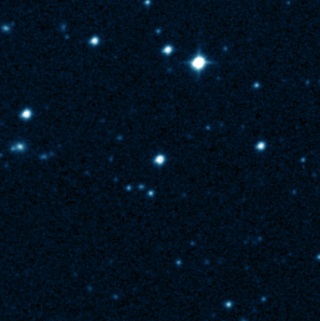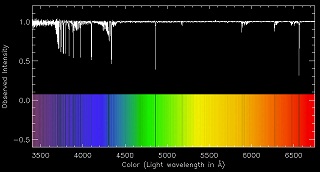SMSS J031300.36-670839.3

SMSS J031300.36-670839.3 |

|
|
| Home | X-Objects | Stars | Habitability | Life | |
 Digitized Sky Survey
Digitized Sky Survey
Larger and
jumbo images.
Located around 6,000 light-years
away (possibly in the galactic halo),
SMSS J031300.36-670839.3
is an ancient star that may be
as much as 13.6 billion years
old
(more).
One of the Most Metal-poor Stars Known
On February 9, 2014, a team of astronomers announced their discovery of one of the oldest stars known in the Milky Way's galactic halo. Found as part of the SkyMapper Southern Sky Survey, the star was designated SMSS J031300.36-670839.3 (which can be shortened to SMSS0313), the star has been detected with the lowest abundance of iron known as of early 2014, at less than one ten millionth of our Sun's abundance, Sol's. Located over 6,000 light-years away from our Sun, Sol, in Constellation Hydrus, the Water Snake (03:13:00.36-67:08:39.3, J2000), SMSS0313 is believed to be one of several stars which have been found recently to have the lowest abundance of iron of all stars yet studied, 30 times less than the previous record-holder HE 1327-2326. With a mass smaller than that of the Sun, the star is probably more than 13 billion years old (MIT press release; ANU news release; MU news release; astronomer Anna L. Frebel's web page on SMSS0313; Sci-News.com; and Keller et al, 2014).
 Anna L. Frebel
Anna L. Frebel
Larger and
jumbo images.
The extremely low metals spectrum of
SMSS0313 exhibits no detectable iron
lines (placing an upper limit on iron
abundance) and relatively higher carbon
abundance, identifying it as a very
old, second-generation star
(more).
Astronomers have not yet been able to determine how old SMSS0313 actually is. The chemical composition of SMSS0313 indicates, however, that it may be a very early, second-generation star, which means it may date back as much as just a few million years after stars began forming around 13.6 billion years ago -- within some 200 million years after the Big Bang . As the abundance of carbon in SMSS0313 was ore than 1,000 times greater than iron, the star must have formed after the supernova of only one relatively "low-energy" progenitor, first-generation star (of around 60 Solar-masses), which spewed its outer layer of gas full of carbon dust but lacked the energy to break up and expel much of its iron core before forming a black hole (Keller et al, 2014).
Other Information
Up-to-date technical summaries on this star may become available at: NASA's ADS Abstract Service for the Astrophysics Data System; and the SIMBAD Astronomical Database mirrored from CDS.
Constellation Hydrus was named as the "water snake" because it resembles a rearing snake, with its head erect and body twisted into a sinuous shape. It was noted by Dutch navigators Pieter Dirszoon Keyser (1540-96) and Frederick de Houtman (1571-16270 when they charted the southern skies between 1595 and 1597 on a voyage to the East Indies. The constellation was introduced by Johann Bayer (1572-1625)in his 1603 publication Uranometria. For more information and an illustration of the constellation, go to Christine Kronberg's Hydrus. For another illustration, see David Haworth's Hydrus.
For more information about stars including spectral and luminosity class codes, go to ChView's webpage on The Stars of the Milky Way.
© 2014 Sol Company. All Rights Reserved. |